-
Products
- Local Securities
- China Connect
- Grade Based Margin
- Stock Borrowing & Lending
- IPO
- Stock Options
- Foreign Stocks
- Unit Trust
- Local Futures
- Foreign Futures
- Forex
- Bullion
- Insurance Services
- Bond
- Monthly Investment Plan
- Mortgage
- Other Services
- Surplus Cash Facility
- Phillip Premier
- Latest Insurance Promotion<
- ETF
- Smart Minor (Joint) Account
- Capital Management
- Research
- Market Info
- Education Center
- Phillip Apps
- Customer Service
- About Us
-
Surplus Cash Facility
Weekly Specials
Bank of China (3988.HK) - Better-than-expected profit performance
Tuesday, January 13, 2015  15105
15105
Bank of China(3988)
| Recommendation | Buy |
| Price on Recommendation Date | $4.390 |
| Target Price | $5.500 |
Weekly Special - 425 Minth Group
Summary
-According to BOC's (or the Group) 3Q2014 results, as at the end of Sep 2014, net interest income was RMB238.775 billion, up 14.68% y-y, which maintained stable growth. BOC's after-tax incomes reached to RMB136.798 billion, increased by 9.16% y-y, and net profit recorded RMB131.133 billion, up 9.09% y-y;
-The Group's total assets was RMB15.43 trillion, and total liabilities amounted to RMB14.38 trillion, with net assets of RMB101 million, increased by 11.20%, 11.38% and 8.82% respectively compared to the end of 2013. ROAA and ROAE were 1.24% and 18.03% respectively;
-BOC's asset quality trends to go down, NPLs amounted to RMB90.695 billion, with the NPL ratio of 1.07%, up 0.11ppts compared to the end of 2013, while the coverage ratio decreased to 207.70%;
-As at the end of Sep 2014, the Core Tier-1 Ratio and CAR of BOC increased obviously by 1.15ppts and 1.29ppts to 10.51% and 13.07% respectively compared with the end of 1H2014. Meanwhile, in 4Q2014, the Group issued the preferred stock with the amount of USD6.5 billion successfully, the first domestic listed company to issue the preferred stock, which would be helpful for increasing the CAR in future;
-Considering the better-than-expected performance, and the positive outlook of the market in 2015, we believe BOC's profit would maintain stable growth, and based on 3-stage DDM, we increase BOC's 12-month target price to HK$5.50, around 25.3% higher than the latest closing price, equivalent to 6.5xP/E and 1.1xP/B in 2015 respectively, the valuation is reasonable. We maintain BOC at Buy.
Better-than-expected profit performance
By the end of Sep 2014, net interest income was RMB238.775 billion, up 14.68% y-y, which maintained stable growth. BOC's after-tax incomes reached to RMB136.798 billion, increased by 9.16% y-y, and net profit recorded RMB131.133 billion, up 9.09% y-y.
The Group's profit performance was better than our previous expectation slightly, mainly due to the sustainable growth of net interest incomes benefited from the stable increase of NIM, as at the end of 3Q, NIM recorded 2.26%, although it was lower than that of 1H, 0.02ppts higher than the of end of 2013.
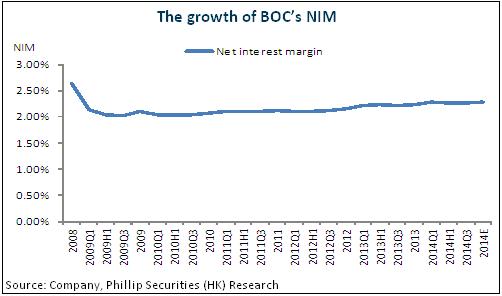
Stable growth of assets with the deterioration of the quality
BOC's total assets was RMB15.43 trillion, and total liabilities amounted to RMB14.38 trillion, with net assets of RMB101 million, increased by 11.20%, 11.38% and 8.82% respectively compared to the end of 2013. Total customer loans increased by RMB836.612 billion or 11% to RMB8.44 trillion compared with the end of 2013.
Due to the large growth of loans and under the downward trend of macroeconomic environment, BOC's asset quality faces the risk of the deterioration. By the end of Sep 2014, the Group's NPLs amounted to RMB90.695 billion, with the NPL ratio of 1.07%, up 0.11ppts compared to the end of 2013, of which special-mentioned loans decreased by 0.20ppts to 2.29%, but doubtful and loss loans should increase obviously. Meanwhile, the coverage ratio decreased to 207.70%, and allowance for loan impairment losses to total loans of domestic institutions was 2.72%, up 0.1ppts. In future, BOC will control the loans for the local government financial vehicles (LGFVs), and strengthen the risk control of industries with excess capacity, property, wealth management and other new businesses.
However, we expect BOC's NPL ratio and amount will increase continually, and the NPL ratio would reach to 1.10% approximately in 2014.
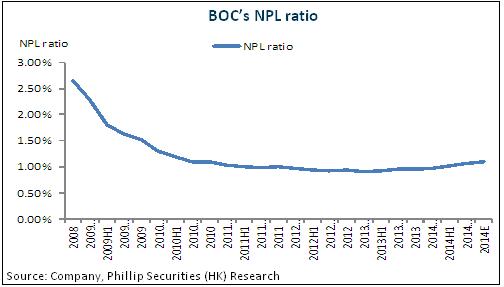
Capital pressures decreased
As at the end of Sep 2014, the Core Tier-1 Ratio and CAR of BOC increased obviously by 1.15ppts and 1.29ppts to 10.51% and 13.07% respectively compared with the end of 1H2014. Meanwhile, in 4Q2014, the Group issued the preferred stock with the amount of USD6.5 billion successfully, the first domestic listed company to issue the preferred stock, which would be helpful for increasing the CAR in future, representing the decrease of the capital pressure, however, it was still lower compared with the peers.
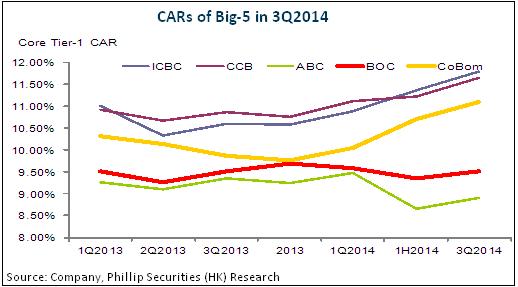
Risk
Lower-than-expected growth of main business incomes;
The deterioration of the asset quality due to the sharp growth of the NPLs;
Share price goes down largely in the short run.
FINANCIALS
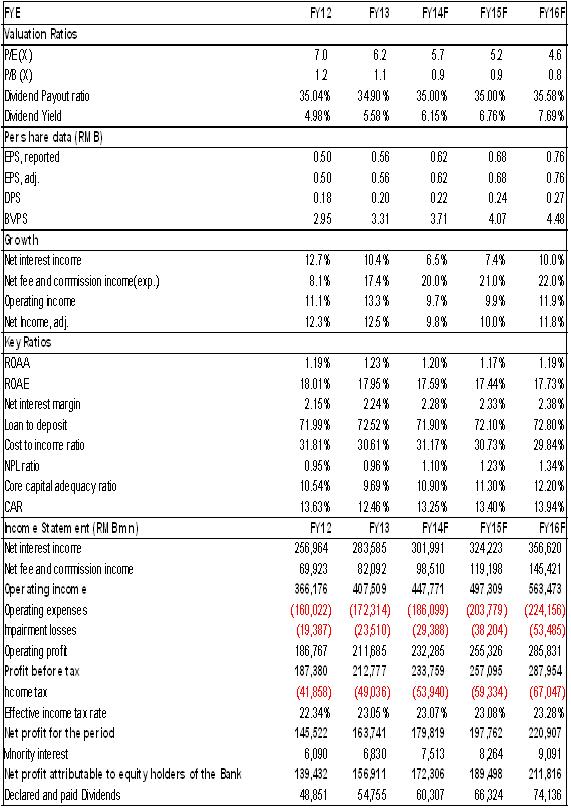
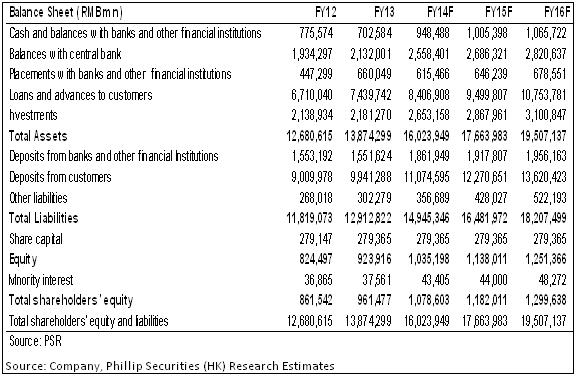
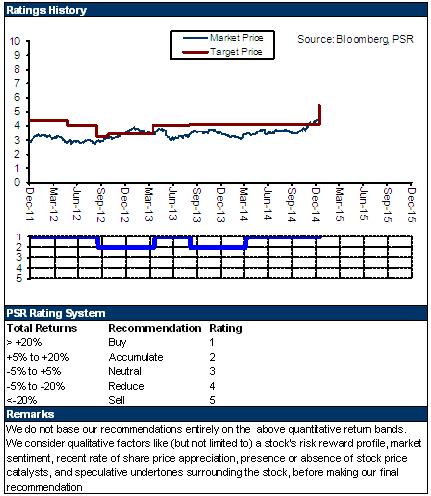
This report is produced and is being distributed in Hong Kong by Phillip Securities Group with the Securities and Futures Commission (“SFC”) licence under Phillip Securities (HK) LTD and/ or Phillip Commodities (HK) LTD (“Phillip”). Information contained herein is based on sources that Phillip believed to be accurate. Phillip does not bear responsibility for any loss occasioned by reliance placed upon the contents hereof. The information is for informative purposes only and is not intended to or create/induce the creation of any binding legal relations. The information provided do not constitute investment advice, solicitation, purchase or sell any investment product(s). Investments are subject to investment risks including possible loss of the principal amount invested. You should refer to your Financial Advisor for investment advice based on your investment experience, financial situation, any of your particular needs and risk preference. For details of different product's risks, please visit the Risk Disclosures Statement on http://www.phillip.com.hk. Phillip (or employees) may have positions/ interests in relevant investment products. Phillip (or one of its affiliates) may from time to time provide services for, or solicit services or other business from, any company mentioned in this report. The above information is owned by Phillip and protected by copyright and intellectual property Laws. It may not be reproduced, distributed or published for any purpose without prior written consent from Phillip.
Top of Page
|
Please contact your account executive or call us now. Research Department Tel : (852) 2277 6846 Fax : (852) 2277 6565 Email : businessenquiry@phillip.com.hk Enquiry & Support Branches The Complaint Procedures |
About Us Phillip Securities Group Join Us Phillip Network Phillip Post Phillip Channel Latest Promotion 新闻稿 |
E-Check Login |
Investor Notes Free Subscribe |

|




